Stellar Birth and Middle Age
What's covered here:
- How do stars form? What are the basic ingredients? How does it occur?
- How did a star like the Sun form?
- What happens during the Main Sequence phase of a stars life?
- How do stars create energy?
- What is the internal structure of a star like?
- What determines the life span of stars?
Star formation
Before we start with the ways that stars are formed and evolve, there
needs to be some explanation as to how astronomers can actually talk
about this stuff. Typically stars take millions or billions of years to
live their lives, so it is not possible to sit down behind a telescope
and watch a star live out its entire life. We just don't live that long.
However, we do have some things to help us understand what is going on.
One of these tools is the H-R diagram.
We can't actually see an individual star evolve, so we need to
look at a large number of stars at once. When you observer many stars, you have a pretty
good chance of catching stars in different stages of their lives. The
more stars you observe, the greater your chances of finding a star in
one of the shorter, harder to catch phases. If you observe thousands or
millions of stars and describe their characteristics on the H-R diagram
(temperature and luminosity), you will see that there are patterns to
their distributions on the diagram. The information in H-R diagrams,
coupled with computer models and physical theories, help us to
understand processes that we can't even see - or at least they give us
a good starting place to work from. By observing as many stars as
possible, we have a better chance of piecing together the picture of
stellar evolution. What characteristics of a star change over time? We
can see the changes in temperature and luminosity, which results in
their changing positions on the H-R diagram. These are both coupled with radius,
so that changes as well. The masses of some stars are observed to change, and to
do so requires certain processes to operate inside the stars.
We also know that the generation of energy inside of a star
will change its internal composition, especially in the core. When you change its
composition, you change its internal structure, which of course has an
influence on how it gives off energy and how hot its surface is and how large
its radius is and so on. In
this way everything is sort of tied together - mass, temperature,
luminosity, radius, and chemical composition. As you'll soon learn, one
of these physical characteristics will really have the greatest
influence and basically determines most of the other characteristics of a star
(you'll have to keep reading to find out which one is the
most important; you think I'd give away the answer this early?).
When we describe the changes in a star's temperature and luminosity,
its position on the H-R diagram changes - we often stay that it "moves"
on the H-R diagram. THIS DOES NOT MEAN THAT IT MOVES IN SPACE!!! The
"motion" is just the changes in the temperature and luminosity of the star
that we can observe. Stars do move through space but this doesn't
usually effect their lives. Don't get confused by the references to
"moving" on the H-R diagrams - it's just showing how they change their
surface temperature and luminosity over time.
Raw Material
As you just learned, stars are made primarily of hydrogen and helium with only a small fraction of their
mass (about 2%) made up of all of the other elements. So in order to make stars you need a lot of hydrogen
and helium. When we look out into space, we can easily detect many clouds of hydrogen floating around in our
galaxy. Helium isn't easy to detect since it is a noble gas and doesn't show up in surveys of the sky using any
type of telescope.
While there is mainly hydrogen floating around between the stars, in what we call the interstellar medium,
there is also a little bit of dust also there - that's part of the 2% that makes up stars. This dust is very important
for several reasons. Since each dust particle is more massive than a gas particle, it has a greater gravitational pull and
would help in the process of forming stars. Also it can block energy/light that could break apart molecules. Another
very important aspect of dust is its influence in our view of the sky. Dust is so good at blocking light that star light can
not easily travel through clouds of dust and because of this many stars are not visible to our eyes. And if the dust does not entirely
block the light it can just make stars look dimmer - this can really mess up our calculations of their distances since
we think that the stars are fainter than they really are.
When you look up at the fuzzy band of the sky that we call the Milky Way you are looking at the thickest concentration
of the gas and dust in our galaxy, and also where a lot of star formation is occurring - where the hydrogen and helium
gets concentrated into stars. But enough about the raw ingredients, let's get to making some stars!
Stellar Birth
Observing stellar birth is rather tricky, since it happens so quickly
(relatively speaking), and it is often not directly visible but is
buried under layers of gas and dust. There are actually two main types
of star formation - the large and small scale, or simply the formation
of many stars at once and the formation of only a few stars. Obviously
the large scale star formation will be easier to observe and it is
sometimes really apparent. We'll look at that process first.
Large Scale star formation
When we look into the sky, we often observe stars in groups - these
groups are often dominated by massive, young, hot stars. By this I mean
these hot, big stars outshine all of the other stars, so that you might
not even notice the small stars that are there. These stars are
gravitationally bound together, so it is reasonable to conclude that the
stars were formed together. To form so many stars (hundreds, thousands
or more) requires a lot of resources. What is needed for large scale
star formation? You need to have a lot of the basic material that goes
into stars, hydrogen and helium (or H and He for short).
Looking out into the galaxy, we can find many Giant Molecular Clouds (GMCs). As the name implies, these
are large clouds of gas and dust. They have very distinctive
characteristics:
- Masses of these clouds are typically on the order of millions of
solar masses, and on some occasions up to billions of solar masses
(that's the Giant part).
- They are cool, around 10 K (this is logical since there are a lot
of molecules in them which would not normally exist in a hot
environment).
- Gases are generally found in molecular form, with such molecules
as H2, CO, CO2, CH, H2O, SiO, etc.
Actually, about 150 different molecules have been found in GMCs, some
with up to 70 atoms! Some of these molecules are linked with the
formation of life (as seen in this recent finding from the
Herschel
infrared
telescope).
There are a few thousand GMCs in our galaxy, and they tend to be found
in the areas of large scale star formation and near very massive, hot
stars. GMCs are so cool that the only way that they can be detected is
with telescopes that detect their very low energy light - in this case
radio telescopes would be best. They are very good for detecting
complex molecules in space. You might know these regions as the Spiral Arms of a galaxy (we'll get to
those later on in the course). GMCs are basically the raw materials
that make up stars. There is only one problem - they don't want to be
stars (obviously they should not go to Hollywood). Cool gas clouds tend
to want to stay as they are - as cool gas clouds. In this way, GMCs are
sort of like Nerf balls - they resist squeezing. If you were to squeeze
them together just a little bit, they would tend to heat up, and this
increases the motions of the material in the clouds (atoms and
molecules), which increases the gas pressure, and this will counter-act
the squeezing. If you want to make stars, you have to squeeze the GMCs
so hard that they can't resist or overcome the force of gravity!
Somehow or another a very strong force of compression must be exerted
upon a gas cloud, so much so that it can't counteract it with an
increase in the gas pressure. After all, without the compression, there
would be no stars formed and if that were the case, then we won't have
anything to talk about - and that would be really boring, wouldn't it?
Where does the compression come from? It doesn't really matter where it
actually comes from, it just has to be strong enough to counteract the
ability of the cloud to resist compression. You'll later learn about
some of these compression mechanisms that are out there that can do the
trick.
Let's say we get the thing compressed by some strong force. What
happens to a GMC when you do compress them?
As with anything, when you start to compress it, material gets
closer together. According to Newton's law of gravity, a decrease in
distance leads to an increase in gravity (remember, gravity goes up as
distance goes down). The material is feeling a higher gravitational
pull (the gravity that each bit of the cloud feels from all of the
other bits). If gravity is strong enough, it will bring the material
together even more, which will increase the gravity and bring the stuff
even closer, which increases the gravity... you sort of get the idea.
Once you overcome the barrier of the cloud's resistance to the
compression, it will pretty much give up and start collapsing down.
This will continue until the individual stars form - remember, stars
are just big gas balls, so as various parts of the cloud clump
together, they will form clumps of gas which become stars. Figure 1
shows how this happens. You might want to make note of the fact that
only part of the GMC will get compressed and have star formation
occurring - not the entire cloud. With each batch of new stars forming,
there could be hundreds or thousands of stars created at one time.
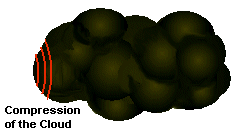 Figure
1. The compression of a GMC occurs only in a small part of the
cloud. The rest of the cloud is not effected. It should be noted that
the colors shown here are not accurate - in general you can't even see
the clouds since they are so dark. They would appear like a black
region to the eye.
Figure
1. The compression of a GMC occurs only in a small part of the
cloud. The rest of the cloud is not effected. It should be noted that
the colors shown here are not accurate - in general you can't even see
the clouds since they are so dark. They would appear like a black
region to the eye.
What kinds of stars will form? Will they all be big stars? Will they
all be little stars? The variety of stars that form is sort of like the
variety of pieces of glass you get when you break a window or a
drinking glass. Usually there are many small pieces - these would be
the very low mass stars, which (when they reach the the Main Sequence)
are the K, M, L and T types (less
massive than the Sun). There will be few of the more massive stars, the
A, F and G types (which have masses similar to the Sun) and very few of
the really big stars, the O and B types. This kind of makes sense,
because we see very few O and B stars out there - they are pretty much
outnumbered by the little stars. As you'll see there is another
reason why O and B stars are so rare, while the little ones are so
common, but we'll get to that later.
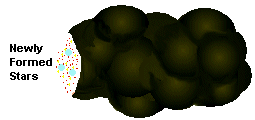 Figure 2. The part of the cloud that was compressed
breaks up into stars in a distribution with few large, hot stars (OB
stars); more middle sized stars (AFG types); and many, many cool, small
mass stars (KLMT types). The coolest stars would not be visible to the
eye since they are mainly infrared sources.
Figure 2. The part of the cloud that was compressed
breaks up into stars in a distribution with few large, hot stars (OB
stars); more middle sized stars (AFG types); and many, many cool, small
mass stars (KLMT types). The coolest stars would not be visible to the
eye since they are mainly infrared sources.
Even though they are greatly outnumbered, the big stars, the O and B
types, are the most important ones in the group. Why are they so
important? What characteristic do these stars have that set them apart
from the other stars? They are very hot! These beasts are so hot that
they give off a lot of UV radiation. UV radiation is very important
since it can ionize the gas around the stars (it ionizes the hydrogen
mainly). Remember, when light ionizes something it means that it knocks
an electron off of an atom. This happens quite a bit, as does the
reverse process (the electron getting back into an orbit around the
atom). The end result is that the gas glows. You get a lot of hot
glowing hydrogen gas and perhaps other types of gas that are glowing,
though there is much more hydrogen around the star formation region than anything
else.
Now we have a region around the hot O and B stars that is just a
huge cloud of hot glowing ionized gas (hydrogen). Such a region is
called an H II region - the
Roman numeral II means that one electron has been lost. How would you
pronounce the name of this region? You say "H two." That makes it a bit
confusing, since it sounds the same as saying H2, which is
how we refer to molecular hydrogen. Yes, it is confusing, but we like
it like that. Just remember, H II indicates that you are talking about
hot, ionized gas, while H2 indicates that you are talking
about cool, molecular gas.
We have to get back to the star formation region and see what's
happening there. The O and B stars are quite effective at ionizing the
hydrogen. They can ionize a large area around them, producing a very
bright H II region. When you observe these regions you are basically
seeing hot, thin, glowing gas (mainly H). If you were to look at the
light from the H II region, you could obtain a spectrum of it - what
type of spectrum? An emission spectrum - remember, that is what is
produced by a hot gas. The emission spectrum of hydrogen has a very
strong red line in it, so there is often a rather pink-ish glow to
these regions. Another tell tale sign that you are looking at an H II
region is that there are often traces of the cool molecular gas that
usually look like dark blobs. This is because it has dust in it and the
gas in these dark clouds isn't hot enough to emit light, like the H II
region gas can. It is sort of neat that these very different gases can
be right next to one another. Other things to look for in the H II
region are the culprits that are causing all the trouble - the O and B
stars. These will be the brightest of the stars in the area, so they
often stand out quite well. You may also note that these stars tend to
be very bluish. Figure 3 shows the characteristics in and around an H
II region.
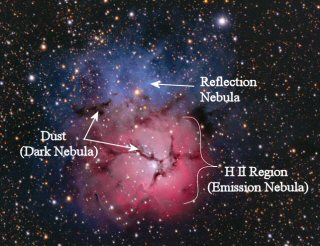 Figure 3. The Triffid Nebula (M 20) is a good
example of an H II region since it shows the different features around
it. First of all is the H II region itself - distinguished by the
pinkish glow. Next is the presence of dark dust that blocks
light. This is referred to as a dark nebula or just basically dust.
However, under certain conditions, it will not look black but instead
will appear blue as is seen on the right. A reflection nebula is just a
region of dust that is reflecting blue light towards you. These bluish
regions are not always seen around H II regions but are seen often enough to
be recognized. They can also be seen in other circumstances.
At the center of the H II region are
the hot stars that are maintaining the high temperature of the gas in
the region. The image is over exposed so that these stars are not
visible amongst the hot gas. To see another view of the Triffid
Nebula, just click here. This shows both the
visible light view as seen at the left and an infrared view, as seen by the
Spitzer telescope. The IR view shows the extent of the gas and dust,
often in areas that aren't seen in the visible light view.
Figure 3. The Triffid Nebula (M 20) is a good
example of an H II region since it shows the different features around
it. First of all is the H II region itself - distinguished by the
pinkish glow. Next is the presence of dark dust that blocks
light. This is referred to as a dark nebula or just basically dust.
However, under certain conditions, it will not look black but instead
will appear blue as is seen on the right. A reflection nebula is just a
region of dust that is reflecting blue light towards you. These bluish
regions are not always seen around H II regions but are seen often enough to
be recognized. They can also be seen in other circumstances.
At the center of the H II region are
the hot stars that are maintaining the high temperature of the gas in
the region. The image is over exposed so that these stars are not
visible amongst the hot gas. To see another view of the Triffid
Nebula, just click here. This shows both the
visible light view as seen at the left and an infrared view, as seen by the
Spitzer telescope. The IR view shows the extent of the gas and dust,
often in areas that aren't seen in the visible light view.
There are quite a few examples of H II regions, though one of the
most spectacular is the Orion Nebula (Figure 4), which is visible in
the winter sky. Other star forming region are shown in Figure 6.
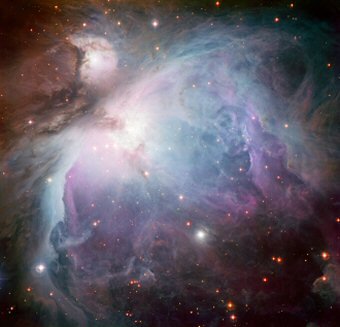 |
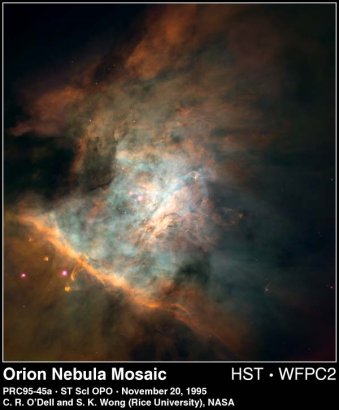 |
| Figure 4. A large view of the Orion Nebula, visible in
the winter sky. Image credit:
ESO/Igor Chekalin |
A Hubble Space Telescope view of the inner region of the
Orion Nebula. Compared to the other image, this covers only a tiny
fraction of the bright inner core. To see how the image was obtained
by the HST, you can view a little movie of it
here. Image credit: NASA and C.R. O'Dell
and S.K. Wong (Rice Univ.) |
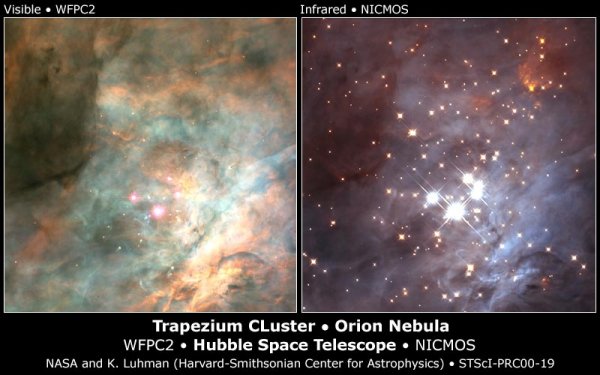 |
Figure 5. Two Hubble Space telescope views of the central part
of the Orion Nebula. The image on the left shows the visible light
view. In this view you can see the four hot stars in the center that
form the "Trapezium" and provides most of the energy that keeps the
nebula hot. Also, individual gas and dust clouds are visible. The
image on the right was obtained with an infrared camera on the
Hubble, and in this instance, the many small, newly formed stars are
visible. Notice how many of these stars are not visible in the image
on the left. Credits for near-infrared image: NASA; K.L. Luhman
(Harvard-Smithsonian Center for Astrophysics, Cambridge, Mass.); and G.
Schneider, E. Young, G. Rieke, A. Cotera, H. Chen, M. Rieke, R.
Thompson (Steward Observatory, University of Arizona, Tucson, Ariz.)
Credits for visible-light picture: NASA, C.R. O'Dell and S.K. Wong
(Rice University). |
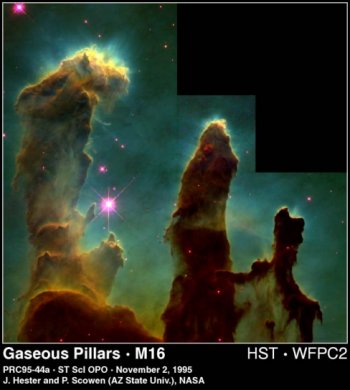
Figure 6. The Eagle Nebula (M 16) - this is another
region of star formation, but unlike the Orion nebula, the stars are
not formed on the inside of the cloud but are being formed on the outer
edges. The huge pillars of gas shown are quite large, with the one on
the left being about 1 light year long from top to bottom. There are
bright stars located above the pillars (which are visible in x-rays
as can be seen in this image) which are blowing away gas from the
pillars. The gas that remains behind forms into stars. Image
credit (both images): Jeff Hester and Paul Scowen (Arizona State
University), and NASA. |
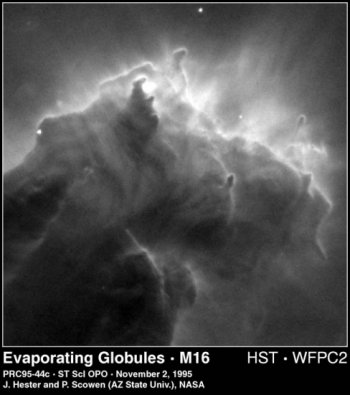
Close-up This shows the top of the pillar on the left.
The long tube-like structures on the edges of the cloud are parts of
the cloud that are breaking away and forming into stars. These areas
appear to contain a concentration of gas and dust that doesn't get
entirely blown away by the hot massive stars located above the cloud.
Whatever remains behind will eventually become a star. |
A bunch of stars have been formed. What happens now? It is possible
that the formation of stars will lead to further star formation. How
does that happen? The new stars, again the O and B ones especially,
have some rather strong winds. These winds can compress other parts of
the GMC and you know what happens when you compress a gas
cloud, right? Star formation! Tt is possible for the whole process to
continue like a domino effect until the cloud is gradually used up. In a way, the star
formation process slowly eats away the GMC. This also tells us that
when you see a region of star formation, there should be a pretty big
gas cloud in the area, much larger in size than the H II region that is
visible to your eye. There can also be a rather negative side effect to
having such massive stars involved. As just mentioned, these stars have
pretty strong winds. In Figure 6 the effects of some of these strong
winds are obvious, they can blow apart gas clouds - so it is
possible that some stars-in-the-making could be destroyed in the
process. Take a peak at Figure 7 for a view of some of these wanna-be
stars (which we call proplyds), and you may also want to check
out this animation showing the inside of the
Orion nebula and the future evolution of the stars in it (we'll get to
that later). In the animation you may notice how many of these blobby
stars are elongated - stretched out - by the strong winds from the hot
stars near the center of the nebula. Here
is an animation showing the zoom into the Hubble image and revealing
the proplyds as they really are - some of these are shown below in
Figure 7. In general these objects are several times larger than
our solar system (hundreds of A.U.s in size), but as they evolve, they'll
lose their cocoon of gas and dust.
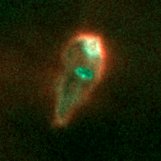 |
 |
Figure 7. Two stars in the process of forming in the
Orion Nebula, as seen by the Hubble Space Telescope. These "proplyds"
(as they are called) are more gas cloud than star at this point and
are feeling the effects of the strong stellar winds near them. Each
proplyd is several times larger in size than our entire solar system
and they have a long way to go until they become stars - mainly they
have to shed a lot of their outer layers. Image credit: NASA, J. Bally
(University of Colorado), H. Throop (SWRI), C.R. O’Dell (Vanderbilt
University). |
Of course, the formation of so many stars at once is easily noticed,
particularly because many of these stars stay in groups or clusters.
Sometimes these clusters are sitting right next to H II regions - which
also helps us see where star formation is going on in the galaxy. Where
the stars form in a relatively loose group that eventually breaks
down (what's known as an association), it is harder to track the point
of origin for the stars.
The Orion nebula has been mentioned as a good example of an H II
region, and it is also one of the most studied ones out there. This is
due in part to its relatively close distance to us (about 1500
light-years away) and the fact that the part of the nebula facing us is
the part where all the action is. You are sort of looking straight in at
the star formation, so it is rather obvious what is going on. The hot
stars really give it away. Often, we don't have such a good view. If we
were on the wrong side (the cool dark side) of the GMC, we would not be
able to see any hot stars or H II regions since the cool gas and dust
would block our view. To see anything that is made up of cool gas and
dust, we cannot use visible light telescopes, but rather IR telescopes.
The IR images that are of star forming regions show not only the stars
and gas associated with the star formation but also the gas that isn't
currently involved in any star formation, since cool gas and dust show
up easily at these wavelengths. IR telescopes reveal the presence of a
lot of "invisible" material, which can eventually go into the formation
of stars. Figure 5 shows many of these strong, newly formed infrared
stars in the Orion Nebula. Here is an image
from the VLT (visible light) and the Spitzer space telescope showing
a region of star formation. The cloud's dark dusty appearance hides all
of the star formation that is going on, which can be seen with the Spitzer's infrared eye. It also helps that the stars in this cloud are also
"misbehaving" by blasting material out - a good way to spot young stars
as you'll see in the next section. The basic lesson here is don't just
trust what you can see with your eyes - use other "eyes" like radio and
infrared to get the entire picture!
GMCs are needed for large scale star formation. The formation is so
massive that it can be seen over a great distance - even in other
galaxies, since OB stars and H II regions are very bright. However, not
all stars are found in such groups, so there must be a way to do small
scale star formation. After all, the Sun is not part of a large group of
stars - so we need to make stars on a smaller scale. We'll look at how
that happens next.
Small Scale Star Formation
It is possible to have only a few stars form, rather than thousands of
stars forming. These are formed from obviously much smaller clouds of
gas and dust. From such clouds only a few stars or maybe only one star
will form. Such clouds are typically only around 10 solar masses in
size. These gas clouds are pretty small and difficult to find due to the
fact that not only are they small, but they tend to be cool - they
don't give off any or hardly any visible light. I guess we could
call them PMC - puny molecular clouds.
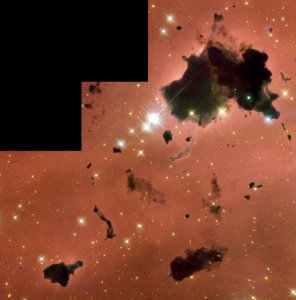 Figure 8. A Hubble Space Telescope image of some
dark, small mass clouds. While these clouds look pretty dusty, they
really don't have that much dust in them; maybe only 1% is dust. The
dust, though, is very efficient in blocking out the light.
Image credit: NASA and The Hubble Heritage Team (STScI/AURA).
Figure 8. A Hubble Space Telescope image of some
dark, small mass clouds. While these clouds look pretty dusty, they
really don't have that much dust in them; maybe only 1% is dust. The
dust, though, is very efficient in blocking out the light.
Image credit: NASA and The Hubble Heritage Team (STScI/AURA).
They are already small to begin with, so it is easier to get them to
compress, though there is less mass involved (remember, gravity depends
strongly on distance, with a small distance having a very large
gravitational pull). As in the case of large scale star formation, these
clouds will give off light primarily in IR wavelengths. However there wouldn't be
any easy to see H II regions, since it is unlikely that large stars will
form in this small scale process. The stars that do form are buried inside of the
dusty cloud and are rather cool protostars.
Protostars are what you'd call something that isn't quite a star yet, but is more star-like
than cloud-like. The reason it isn't a star yet, is because it hasn't started
any fusion processes - the mechanism by which stars make energy. I'll get to
fusion in a little, just hang on a bit.
It is very difficult to spot these critters, since not
only are they cool stars, but they are also buried deep inside the dust
and gas cloud.
As the small gas cloud compresses, it often flattens out into a disk.
Why does it do that? It is sort of like the way that good old fashioned
pizza is made. When the dough is being shaped, it is often spun around - this
stretches it out. In the case of these small gas clouds, they are
already spinning around, and spinning things that are compressing have a
tendency to flatten out into disk shapes. It is possible to find these
stars by looking for the disks around them - since the disk can be much
larger than the star. Figure 9 shows some of these disks around young
newly forming stars. In case you were wondering, yes, this is a way
that planets can get formed - the material in the disk can eventually
form into planets. Now you should be wondering about whether disks
would form around the big stars - you were wondering that, weren't you?
It is possible that disks could form around them, but since they are in
groups, there is also a greater chance that the other stars in the area
could mess up and destroy any disks. Also, the very strong winds that are
produced by massive stars would disrupt a
disk of material very quickly.
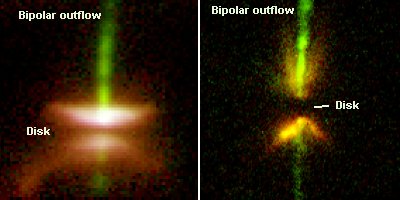 Figure 9. Disks around young protostars are shown in
these two Hubble images. In both cases the disks are tilted so that
they are seen edge on. There is dust in the disks, so they tend
to look very dark and are hard to see. This is especially
true for the disk on the right. Some hot gas around the newly forming
star is seen above and below the disk, while material getting shot out
from the poles (which look green here) indicates that there is a young
star in the middle (this will be explained further down the notes).
Image credit: Chris Burrows (STScI), John Krist (STScI), Karl
Stapelfeldt (JPL) and colleagues, the WFPC2 Science Team and NASA.
Figure 9. Disks around young protostars are shown in
these two Hubble images. In both cases the disks are tilted so that
they are seen edge on. There is dust in the disks, so they tend
to look very dark and are hard to see. This is especially
true for the disk on the right. Some hot gas around the newly forming
star is seen above and below the disk, while material getting shot out
from the poles (which look green here) indicates that there is a young
star in the middle (this will be explained further down the notes).
Image credit: Chris Burrows (STScI), John Krist (STScI), Karl
Stapelfeldt (JPL) and colleagues, the WFPC2 Science Team and NASA.
A star with the mass of the Sun in this stage of its life would have a
surface temperature of only about 4000 K and a radius about 20 times the
Sun's current radius. The luminosity is rather large, mainly due to the large
radius, typically about 100 times the Sun's.
These stars are cool and luminous. Are these stars Red Giants? No, as
you'll learn, Red Giants are stars near the end of their lives, while
these protostars haven't even ripened (haven't "turned on" yet). They do
have similar outward appearances, but what is going on inside a Red
Giant and a protostar is quite different (of course we can't see inside
of them directly; we just think we know what is happening inside the
stars - I'll talk about this more later). Also, protostars in this stage
of their lives evolve very fast, so it is hard to catch them during
this stage. By "fast" I mean around a few million years for the really
small mass protostars to get their act together (become real stars) and
only a few thousand years for the very large mass protostars to become
real stars. Figure 10 shows where these stars are on the H-R diagram
and how they change their temperatures and luminosities as they evolve.
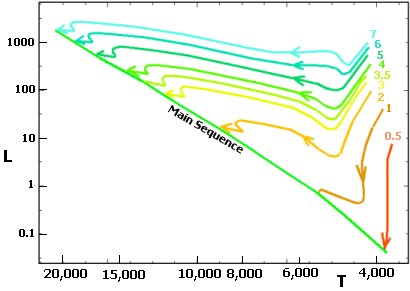 Figure 10.Early stages of stellar evolution,
pre-main sequence. As gas clouds get converted into protostars and the
protostars gradually stabilize into stars, they evolve in a generally
left-ward motion on the H-R diagram (towards higher temperatures). The
lines indicate the paths on the H-R diagram that protostars of
different masses will take as they head towards the Main Sequence.
Graph based upon stellar evolution computer models of
Siess,
Dufour and Forestini.
Figure 10.Early stages of stellar evolution,
pre-main sequence. As gas clouds get converted into protostars and the
protostars gradually stabilize into stars, they evolve in a generally
left-ward motion on the H-R diagram (towards higher temperatures). The
lines indicate the paths on the H-R diagram that protostars of
different masses will take as they head towards the Main Sequence.
Graph based upon stellar evolution computer models of
Siess,
Dufour and Forestini.
Also with small scale star formation, it is very difficult to find
protostars when they are still surrounded by gas and dust. Once they do
get close to the Main Sequence, they often start making their presence
known by being rather active. I like to think of this as their "terrible
twos stage," sort of like a young child having a temper tantrum -
these small stars do sort of the same thing. This stage, known as the T Tauri Stage (TT - just like
"terrible twos") only happens to small mass stars like the Sun. What
they do is develop very high velocity winds which blow off their outer
layers and the surrounding material (mainly hydrogen). On occasion,
this material will run into other material in the region and form shock
fronts, what we call H-H Objects.
We can see that the various H-H Objects are moving either towards or
away from us, so they have a pretty good velocity away from the
protostar. Figures 11 and 12 show some views of T Tauri stars and their
associated activities, including H-H objects.
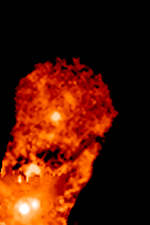 |
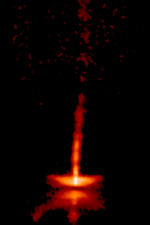 |
Figure 11. Some time lapse images of T Tauri stars.
These are images obtained from the Hubble Space Telescope showing the
mass ejections due to strong winds from young stars (really still
protostars). On the left is XZ Tauri, actually two stars in orbit about
one another. The bubble of material bursting from them is moving at a
speed of about 300,000 mph. On the right is HH 30 - the T Tauri star
that has a disk of material around it and is erupting matter in two
directions - you're just seeing one gusher here. Image
credits: (left) John Krist (STScI), Karl Stapelfeldt (NASA JPL), Jeff
Hester (Arizona State University), Chris Burrows (ESA/STScI); (right)
Alan Watson (Universidad Nacional Autonoma de Mexico, Mexico), Karl
Stapelfeldt (NASA JPL), John Krist (STScI), and Chris Burrows
(ESA/STScI). |
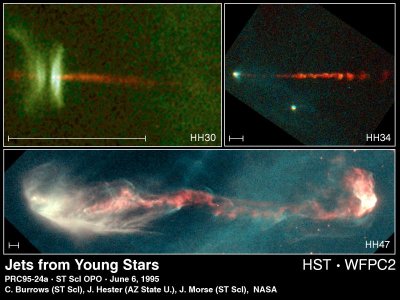 Figure
12. Several T Tauri stars producing some H-H objects. These Hubble
images show mainly the H-H objects, since the T Tauri star is not
visible behind a layer of gas and dust or inside the disk of material.
However, the stream of material being ejected by the star is visible,
and the pile up of the material in the form of the two H-H objects is
also easily seen. You can click on the image to see a larger view.
The scale in each image is the equivalent to 1000 A.U., or 1000 times
the distance between the Earth and the Sun. Credit: C. Burrows (STScI
& ESA), the WFPC 2 Investigation Definition Team, and NASA.
Figure
12. Several T Tauri stars producing some H-H objects. These Hubble
images show mainly the H-H objects, since the T Tauri star is not
visible behind a layer of gas and dust or inside the disk of material.
However, the stream of material being ejected by the star is visible,
and the pile up of the material in the form of the two H-H objects is
also easily seen. You can click on the image to see a larger view.
The scale in each image is the equivalent to 1000 A.U., or 1000 times
the distance between the Earth and the Sun. Credit: C. Burrows (STScI
& ESA), the WFPC 2 Investigation Definition Team, and NASA.
It is interesting to note that the material is being ejected from
the young star only in two directions, known as a bipolar flow. Why doesn't it just
blow material out in a uniform direction or into a random direction? It
is possible that there is some influence from the magnetic field of the
star and/or the presence of a disk of material that would obstruct the
flow of material in any random direction. In some cases disks are
visible, but not all. As you'll see, a lot of things have a bipolar
outflow - this is a very popular way for objects to spew material out
into space. The T Tauri stage is short lived, and the star eventually
settles down and becomes a boring, normal Main Sequence star.
On the Main Sequence (MS)
The "adult" stage of a star's life is when it becomes a Main Sequence (MS) Star. When does
this happen? A star becomes a MS star when it starts fusion reactions in its core. This is
the process that produces the energy in a star's core. Along with these
fusion reactions, there are other characteristics of a star that help
astronomers understand the nature of stars. Some of these properties
make MS stars distinct from others and help us understand the way in
which stars evolve. You have to remember that we have never seen inside
a star, that we can only study what is on the surface, but there are
many ways of figuring out what is going on deep below the surface.
Fusion
How is energy in a star produced? Originally people thought that the
Sun was actually something that was on fire, like a big block of wood or
some sort of "normal" fuel. When people determined how long a big block
of wood, gasoline or some other "normal" fuel would last, they
determined that the age of the Sun would be really young, since these
types of fuels don't last very long. There must be some other mechanism
that is creating the energy. We know
that gravitational compression (squeezing) produces heat, so could
gravity be doing it? No, there isn't enough mass in the Sun to produce
all of the energy we get from it. Eventually, Albert Einstein provided the answer
in his Special Theory of Relativity
(1915). While there were several different formulas and concepts in this
theory, the most familiar is the famous equation
E=mc2
What does this mean? All it really says is that if you convert mass
into energy, you get a certain amount of energy out of the reaction that
only depends upon the mass involved - the more mass, the more energy.
The formula doesn't tell us how the energy is
produced from the mass, but just gives us a way to measure the amount of energy produced. Other
physicists came along and determined the processes where the mass is
converted into energy, but Einstein is the one who showed that mass and
energy are related. As you'll see this formula can go either way - you
can convert mass into energy or energy can be converted into mass.
How do you convert mass into energy? I'm glad you asked. The process is
known as fusion, or the fusing
together of atoms. This is not what goes on in nuclear power plants,
and actually it is rather difficult to do even the simplest fusion
reactions, which sort of explains why we have no nuclear fusion plants
on the Earth. These reactions require very high temperatures and
pressures to work - the main reason it is so hard for people to
duplicate this process on Earth. Sometimes we use the word burning to describe the energy
production in a star, but this is not a very accurate term, since the
material isn't really burning - it just sometimes makes it easier for
people to visualize the process.
The main reaction operating in the Sun and other low mass MS stars
is the Proton-Proton chain (or
the p-p chain). To get this reaction to work you need a temperature of
at least 13 million K and a density of about 100 gm/cc. If you are not
familiar with density, then you might find it interesting that the
density of metal is around 7 gm/cc. This is much denser than most
metals that you come into contact with. Something you might also want
to remember is that a proton is really just a hydrogen atom without an
electron (an ionized hydrogen atom). The core of a star is very hot,
and the atoms are colliding around quite a bit, so it is really easy
for the atoms in the core to get ionized. There are a whole bunch of
protons just bouncing around in the core - but you can also think of
them as hydrogen atoms bouncing around in the core - it doesn't matter
how you visualize it.
Here is the step by step process:
First have two protons come together and form into deuterium
(H2), with by-products of a positron and a neutrino.
Deuterium is an unusual form of hydrogen, sort of like over-weight
hydrogen. The positron (e+) is just like an electron,
except that it is positively charged. A neutrino ( ) is a weird little
particle that is very difficult to detect. Here's the reaction
written out:
H1 + H1 ) is a weird little
particle that is very difficult to detect. Here's the reaction
written out:
H1 + H1  H2 + e+ + H2 + e+ +
|
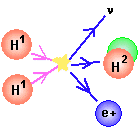 |
Now have the deuterium fuse together with another proton to
form a type of helium that is a bit light weight (He3) and
also a gamma-ray photon  . The gamma-ray is the energy that the star has produced.
Here it is written out:
H2 + H1 . The gamma-ray is the energy that the star has produced.
Here it is written out:
H2 + H1 He3 + He3 + 
|
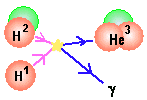 |
Take the light weight helium and have it combine with
another light weight helium to produce normal helium (He4)
with two protons left over .
He3 + He3  He4 + H1 + H1 He4 + H1 + H1
|
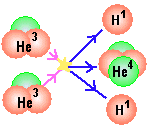 |
Basically, you start with four protons (hydrogen nuclei) and end up
with a helium nucleus (which contains two protons and two neutrons) and
some other stuff (the positron and neutrino, oh yes, and some energy).
If you were to put this stuff on a scale and measure the mass of what
went into the cycle and what came out of the cycle, you would see that
they don't weigh the same. The difference in weight between these items
is the mass used to create the energy in the reaction. Even though only
a minuscule amount of energy is produced in each reaction, stars do this
reaction so many times that there is a great deal of energy given off.
A star like the sun does this reaction about
100,000,000,000,000,000,000,000,000,000,000,000,000 times each second.
Even though a single reaction doesn't produce enough energy to keep a
gnat alive, stars produce a huge amount of energy, since the reaction is performed so often.
In stars more massive than the Sun, another fusion reaction is
at work, the CNO cycle. This
does basically the same thing as the p-p chain but uses other elements,
namely carbon, nitrogen and oxygen, to bring about the production of
energy and the other byproducts (Helium, positrons, and neutrinos).
Fusion is the source of energy (photons) in a star. The density of the
interior of stars is so high that the radiation can't go very far
without being absorbed, deflected and bounced around by all the stuff on
the inside. Actually, it is rather difficult for the photons to go very
far at all without hitting something. The path that the light takes
from the core to the surface is rather chaotic.
The light produced in the core will take a Random Walk towards the surface. This
little walk can take around 200,000 years or even more. At the onset of
the walk, the photon is a high energy gamma-ray, but it loses most of
its energy in all those collisions it has as it works its way through
the Radiative Zone. In this
region, radiation (energy, light, photons, etc.) is transported
according to the rules that govern how radiation interacts with
materials - all of those collisions, absorptions, and emissions
that go on in the dense material. That's why this layer in a star is
called the Radiative Zone.
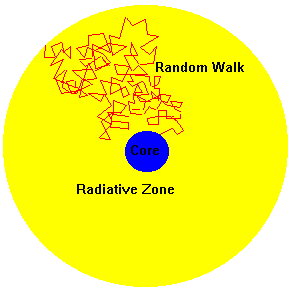 Figure 13. Energy
produced in the center of the Sun (or any other star) bounces around
for years as it works its way towards the surface. This Random Walk
is due to the way that matter and energy interact. The process will
eventually stop once the density of the material is too low for there
to be significant interaction - once it gets out of the radiative zone
in the Sun.
Figure 13. Energy
produced in the center of the Sun (or any other star) bounces around
for years as it works its way towards the surface. This Random Walk
is due to the way that matter and energy interact. The process will
eventually stop once the density of the material is too low for there
to be significant interaction - once it gets out of the radiative zone
in the Sun.
Further out from the center, the material is less dense, so the
radiative processes are not as important. Here the energy is transported
via convection in what is called the Convective
Zone (isn't that clever?).
Remember, convection is also the process you see when you boil a pot
of water on the stove. Energy is transported by the motion of the
material - the churning and bubbling of the gas. At the top of the
convective zone, the gas is thin enough for radiation to easily escape -
these are the layers of the star's surface that we see - the
atmosphere. If you remember the stuff about the Sun's surface, the tops
of the convective bubbles are what we call the granules. The situation
for larger stars is actually quite different - they have the convective
zone near the core with the radiative layer near the surface. This just
has to do with the way that the material acts under different
circumstances - whether there is convection or not going on. Either way,
energy produced in the core of a star, where it was originally
a high energy photon, will eventually get to the surface of the star
where it can then fly off into space in the form of a relatively low energy photon,
usually in the visible part of the spectrum.
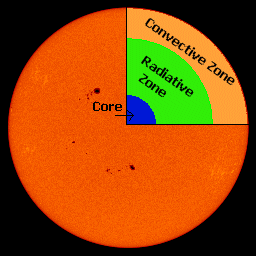 Figure 14. The interior of a star like the Sun is
shown. The three main layers of the core, radiative zone and convective
zone are depicted. For larger stars, the order of the various regions
in the interior does not appear to be the same as is shown here. Those
stars tend to have convection near their cores and their radiative
layer just below the surface.
Figure 14. The interior of a star like the Sun is
shown. The three main layers of the core, radiative zone and convective
zone are depicted. For larger stars, the order of the various regions
in the interior does not appear to be the same as is shown here. Those
stars tend to have convection near their cores and their radiative
layer just below the surface.
Stellar interiors
How do we know what the inside of a star looks like? How can we really
talk about fusion and such with any confidence when it is pretty much
impossible to see anything below the surface of a star? There are
several ways to study the interior of a star. One already mentioned is helioseismology, which can also be
applied to other stars (where it is referred to as asteroseismology). The study of a
star's light is not a good indicator of the interior since it is
altered so much on its journey from the center, and it is also old
light - it takes a long time to travel through all those layers. The
only thing that comes immediately from the center of a star is the
neutrino, one of the by-products of the fusion reaction. Neutrinos are
really weird little critters. These are particles that we don't know
much about, in part because we have a very hard time detecting them.
There are thousands of neutrinos going right through your body right
now. Does it hurt? No, because neutrinos travel through pretty much
everything without causing any problems - they don't interact well with
matter. That's why it is so difficult to study them - we can hardly
ever catch them! It isn't really impossible to study them, but it is
just very difficult. Neutrinos are so elusive, that we are not even sure
if they have mass. Our best current estimates put there mass at less than 5 x 10-37
kg, though we aren't certain about the lower limit to the mass. For comparison, a proton has a
mass of around 1.67 x 10-27 kg, which means that a proton is
at least 3 billion times more massive than a neutrino.
Actually, there was a major problem with neutrino studies of the
Sun. There have been neutrino experiments going on for some time, some
working for over 30 years, and all of the detectors got basically the
same result. We detected fewer neutrinos than we were supposed to detect
based upon the laws of physics. This used to be a major problem in
astronomy since it has some rather nasty aspects. Why were too few
neutrinos detected? Was there something wrong with the inside of the
Sun? If that were the case, it may be bad news for us, since our
existence depends on the Sun. Was there something wrong with all these
theories that we have to explain what happens inside of stars? If that were
the case, we would have some serious conflicts between the rules that we
are using and the experiments where the results do come out okay. Is
there something wrong with the neutrino detectors? Well, every neutrino
detector is different, and every detector seemed to get the same result
- that there were too few neutrinos coming from the Sun.
What's the answer? It seems that neutrinos aren't all alike. Actually,
we knew this previously, but we didn't know that the neutrinos coming
from the Sun do change in subtle ways, becoming a type of neutrino that
is incredibly hard to detect. Before, neutrinos were just really
difficult to observe, but this other type of neutrino was so close to
impossible to detect that no one ever saw it. That was until a really
amazing neutrino detector was built (follow
this link), and it started to
pick up all these very difficult to detect neutrinos. It seems that the
neutrino problem is no longer a problem. Sometimes it takes better
theories to figure out what's going on; sometimes it takes better
equipment.
Looking at neutrinos helps us to figure out what the Sun is like, but
other stars are so far away that it is nearly impossible for us to look
for their neutrinos. How can astronomers figure out what is going on
inside all of the other stars out there? How do we know if there is
convection or radiative energy transport occuring inside of them? In order to
understand how stars work, astronomers must apply several laws of
physics to them and these laws, combined with observations, provide
astronomers with a better pictures of stellar physics. These rules are
- Hydrostatic Equilibrium - This is the balance between
weight (gravity) and pressure (air pressure or gas pressure). This is
like how the old dome on the UNI-Dome worked (and how the Metrodome in
Minneapolis works). The cloth dome was held up by air pressure inside
of the UNI-Dome, while the weight of the dome was always exerting
a downward force due to the pull of the Earth's gravity. The air
pressure and the gravity need to be evenly balanced so that the roof
doesn't cave in - which happened at those times when it wasn't
balanced. A star is similar. The outer layers of the star are being
continually pulled in by the star's gravity. These layers don't fall in
because the high pressure of the gases inside of the star prevent that.
The star is balanced - it doesn't cave in on itself or blow itself
apart.
- Conservation of Energy - Energy is given off but it is
continually produced. Another way of saying this is that stars keep on
shining; there are no gaps in the production of energy. This is
important because it helps regulate the temperature and density inside
of a star. The energy from the core flows out from a star continuously
- it doesn't get trapped inside various regions but flows through them.
This is a good thing, because if it didn't happen, if energy got stuck
in a certain layer, then that layer would heat up to an abnormally high
value, which would screw up the internal structure of the star.
- Conservation of Mass - A star's total mass is the sum of
all of its layers. This one actually sounds kind of silly, because it
is saying if you take all the parts of a star and add them up, you'll
get the total mass of the star. What this rule really does is
account for the fact that not all layers of a star have the same mass -
some layers are thicker than others; some are thinner since the density
inside of a star changes from one layer to the next. You have to
account for this change in density when you do add up all the layers.
It is actually rather important.
- Energy Transport laws - These are the rules governing
energy flow mechanisms such as convection and radiative transport.
These rules also tell us how much energy is being transported by
these various mechanisms; in some layers it is all radiative, in some
layers it is all convective, and in some layers it is a mix of both.
By combining these rules with other laws of physics and observations,
astronomers can make computer models of stars which can then be altered
to show how stars will live their lives. Of course, the results from the
computer models can be compared to observations of stars. This makes
life pretty easy for astronomers since stars take a very long time to
get from one phase of their lives to another, so sitting behind a
telescope and waiting for a star to change is pretty much a waste of
time. A computer can speed up the process quite a bit.
What is the inside of a star like? We know that various physical
characteristics like temperature, density and pressure change as you go
from the center of the star to the surface. In the center the
temperature and density values are the highest (temperatures of several
million K, for example), which is a pretty good thing since there would
be no fusion without these very high temperatures and densities. As you
get further and further from the center of the star, the temperature and
density decrease quite drastically. By the time you get to the surface
of the star, the temperature is in the range of only thousands or tens
of thousands degrees, quite a bit cooler then the core. The density is
really low at the surface. Actually, the density is so low that it is lower than the
density of air molecules in the room that you are sitting in now - the
gas is really thinned out at the surface. Remember, in the core, densities are more
than 10 times the density of lead! Stars are objects of very extreme
conditions. See Figure 15 for some results from a computer model for
the Sun.
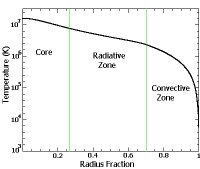 |
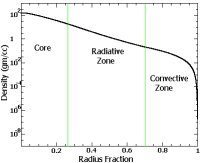 |
| Figure 15. Results from computer models
of the Sun. These graphs show the calculated temperature and density
for a star like the Sun. The graphs are set up with radius increasing
to the right, and extend from the center (where the radius =0) to the
surface (radius=1). The temperature and density values vary over a
wide range of values. Click on each image to see a larger version.
Data is from the solar model of J. Christian-Dalsgaard et al (1996). |
I think that is enough talk about physics and computers. Let's
get back to the Main Sequence discussion. When a star finally turns on
(starts fusion reactions), it is at the starting point of its life on the Main
Sequence. While on the MS, it is burning hydrogen in its core - and
nothing else. Initially stars are said to be on the Zero-age MS, the
point when they have just started to burn their fuel - brand new stars.
Most stars we see in the sky are not on the ZAMS, since they have
generally been burning fuel for some years. The ZAMS is really only a
theoretical concept that is most useful when we make computer models to study
stellar evolution.
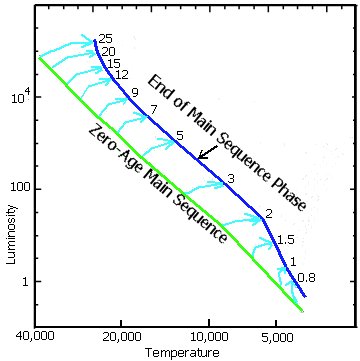 Figure 16. The Zero-Age Main Sequence (or ZAMS) is
shown - it is the green line. This is only a theoretical location on
the H-R diagram and is used to show the likely location where a newly
formed star would be found before it has burned any hydrogen. As stars
undergo fusion they gradually follow the paths indicated by the light
blue lines until they reach the end of their Main Sequence phase -
indicated by the dark blue line. The masses of the individual stars are
indicated. This graph is based on computer model data and is not based
upon actual stars.
Figure 16. The Zero-Age Main Sequence (or ZAMS) is
shown - it is the green line. This is only a theoretical location on
the H-R diagram and is used to show the likely location where a newly
formed star would be found before it has burned any hydrogen. As stars
undergo fusion they gradually follow the paths indicated by the light
blue lines until they reach the end of their Main Sequence phase -
indicated by the dark blue line. The masses of the individual stars are
indicated. This graph is based on computer model data and is not based
upon actual stars.
How long will a star be a MS star? A looooooonnnnngggg time! Stars
spend 90% of their life on the MS. Boy, is it dull! Being on the MS is
sort of like middle age. You get up, go to work, come home, watch tv, go
to bed, repeat. This type of routine is boring! Except, a star never
stops working; it is constantly fusing hydrogen into helium (and making
energy) while it is on the Main Sequence. Main Sequence life spans for a
variety of stars are given in the table below.
It is easy to figure out how long stars will last on the Main Sequence,
since it depends on how much fuel they have (mass) and how quickly they
use it (luminosity). The time a star spends on the Main Sequence can be
approximated using the following formula
time on MS = (1/M2.5)x 10
billion years
where M is the mass of the star in units of solar masses. If
you put the Sun's mass in there - you'd get the time the Sun will
spend on the Main Sequence, about 10 billion years. If you put
in greater masses, the fact that the mass is being divided into10
billion will always give you a shorter time. For example, a 5
solar mass star would give you an age of 1/52.5 x 10 billion
= 1/55.9 x 10 billion = 10 billion/55.9 = 179 million. This
formula is only an approximation, but you can see that a greater mass
means a shorter Main Sequence life. Even though high mass stars
have more mass, they burn it much more quickly and end up having very
short lives (remember the mass-luminosity relation of MS stars?
Massive stars have very high luminosities and use their fuel up very
quickly).
Stars on the MS are arranged in very orderly way -
- At the top left end of the MS- High Temperature, High
Luminosity, High Mass, Short Life (millions of years)
- In the middle of the MS - Medium Temperature, Medium Luminosity,
Medium Mass, Longer Life (billions of years) - this is where you'd find
the Sun
- At the lower right end of the MS - Low Temperature, Low
Luminosity, Low Mass, Long Life (10s or 100s of billions of years).
The entire history of a star, how quickly it forms, where it resides
on the MS, its life span on the MS, the mechanism it uses to produce
energy, its internal structure and what happens to it after it leaves
the MS is dependent primarily on MASS! Pretty much everything about a
star's life depends on its MASS. Don't forget that! The table below gives
some values of time that a star will spend on the Main Sequence based
upon computer models. You would not get these exact ages using the
formula given above, since that is sort of an approximation for all
stars, so it isn't too good in some cases.
| Mass |
Spectral Type |
Years on Main Sequence |
| 25 |
O7 |
6.4 Million |
| 20 |
O9 |
8.1 Million |
| 15 |
B0 |
11.6 Million |
| 12 |
B1 |
16.0 Million |
| 9 |
B2 |
26.4 Million |
| 7 |
B4 |
43.1 Million |
| 5 |
B6 |
94.3 Million |
| 3 |
A0 |
351.7 Million |
| 2 |
A5 |
1.1 Billion |
| 1.5 |
F2 |
2.7 Billion |
| 1 |
G2 |
9.4 Billion |
| 0.8 |
K0 |
22.8 Billion |
Now that you've read this section, you should be able to answer these questions....
- What is needed for large scale star formation?
- What types of stars (mass, spectral type) are formed in large scale star formation?
- How are H II regions formed?
- How does small scale star formation differ from large scale star formation (apart from the size)?
- What are TT Tauri stars and H-H Objects?
- How does the mass of a star influence the pace of its formation?
- What do Main Sequence stars do that makes them Main Sequence stars?
- What happens during fusion in the Sun?
- How does the energy from center of the Sun get to the surface?
- What are neutrinos?
- How are astronomers able to understand the workings of the interiors of stars?
- What does the Main Sequence life span depend upon?
- How do characteristics of stars vary along the extent of the Main Sequence?
 Figure
1. The compression of a GMC occurs only in a small part of the
cloud. The rest of the cloud is not effected. It should be noted that
the colors shown here are not accurate - in general you can't even see
the clouds since they are so dark. They would appear like a black
region to the eye.
Figure
1. The compression of a GMC occurs only in a small part of the
cloud. The rest of the cloud is not effected. It should be noted that
the colors shown here are not accurate - in general you can't even see
the clouds since they are so dark. They would appear like a black
region to the eye.  Figure 2.
Figure 2.  Figure 3.
Figure 3. 






 Figure 8.
Figure 8.  Figure 9.
Figure 9.  Figure 10.
Figure 10.




 Figure 13. Energy
produced in the center of the Sun (or any other star) bounces around
for years as it works its way towards the surface. This Random Walk
is due to the way that matter and energy interact. The process will
eventually stop once the density of the material is too low for there
to be significant interaction - once it gets out of the radiative zone
in the Sun.
Figure 13. Energy
produced in the center of the Sun (or any other star) bounces around
for years as it works its way towards the surface. This Random Walk
is due to the way that matter and energy interact. The process will
eventually stop once the density of the material is too low for there
to be significant interaction - once it gets out of the radiative zone
in the Sun.  Figure 14.
Figure 14. Figure 16.
Figure 16.